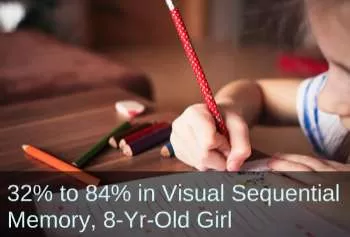Primitive Reflex Integration Case Studies
Struggles with Visual Memory, Hand-Eye Coordination, and Writing All Ease for 8-Year-Old Girl
Neurodevelopmental movements: Help for visual processing, and fine and gross motor skills
This little girl struggled with many tasks. Find out how, through the use rhythmic movements and primitive reflex integration, she drastically improved visual memory, the ability to track objects, handwriting skills, and posture.
Submitted by Sue Lapp OTR/L

| Before | After |
|---|---|
| Sat on knees with head bent forward | Sitting posture improved |
| Walked with head far forward | Better able to maintain her head upright |
| Poor visual memory | Visual memory skills have increased from 33% accuracy to 72% accuracy on average. Visual sequential memory for up to seven targets has increased from 32% to 84% |
| Poor tracking skills and eye/hand coordination | Able to track objects while separating head/eye movements |
| Difficulty forming letters | More consistent forming letters with a top to bottom sequence; reversals have decreased |
El is an eight-year-old girl presently in a second grade co-teaching classroom. I initially evaluated her when she was in kindergarten and she began receiving services twice weekly. She is classified Speech Impaired but her classification does not really describe El. Her IQ is 52 and Classification should be ID (formally MR). In first grade, El’s services were increased to two group and one individual in order to address specifically her reflex integration and visual perceptual delays during her individual time. El does not have a significant birth history.
Prior to taking this class, our focus during therapy was on pre-writing/writing activities, visual perception, reflex integration (ATNR and STNR) and overall strengthening.
I had chosen the ATNR [Asymmetrical Tonic Neck Reflex] and STNR [Symmetrical Tonic Neck Reflex] because she struggled with tracking skills, eye/hand coordination and displayed a variety of posturing; walking with her head forward, unable to control her force and speed of movement and poor safety awareness. Her posture was slumped and tone was lower. Her working memory and executive functioning is compromised.
Since beginning Brain and Sensory Foundations Course:
I immediately began doing rhythmic movements 1-4. The first time I introduced these I could immediately see her whole body relax and she verbalized how much she liked it. We continued these for 2/3 of her scheduled sessions. She began to ask me if today was her “moving day”. Around session six I began doing before and after drawings with huge results noted in the size of her drawings, details and color added. El’s gait has shown improvement at this point, her head is more in line with her body and she was not leading with her head which threw off her center of gravity. I stopped working directly on her perceptual weaknesses since reflex integration work focuses on visual and perceptual skills and added the TLR [Tonic Labyrinthine Reflex] as a reflex of focus in addition to what we were focusing on. I was hoping to better target her coordination, directional awareness and grading of speed and movements. Our sessions always include play activities such as rolling, belly activities, sensory modulation activities. El has participated in approximately 30 sessions since I began this course. The following are areas of noted improvements since beginning rhythmic movements and reflex integration:
- El’s sitting posture has improved and she no longer sits on her knees with her head bent forward while doing her work
- She is better to maintain her head upright rather than leading with it
- Her visual memory skills have increased from 33% accuracy to 72% accuracy on average using a consistent assessment activity
- Her visual sequential memory for up to seven targets has increased from 32% to 84% using a consistent assessment activity
- El is able to track objects while separating head/eye movements
- El is more consistent in forming her letters using a top to bottom sequence and reversals have decreased.
[Edited for length and clarity, emphasis added]
*Disclaimer: The activities in the Brain and Sensory Foundations curriculum make use of the natural processes of neuroplasticity and development that are innately wired in the design of human beings to promote maturity and function. These activities appear to calm, organize, and mature the neuro-sensory-motor systems just as we see in the healthy development of human infants. Individual results may vary, and we do not claim to offer a diagnosis or cure for any specific condition or disorder. The Brain and Sensory Foundations activities appear to improve overall functioning resulting in measurable improvements for a range of conditions as demonstrated in over 1800 case studies from participants.

